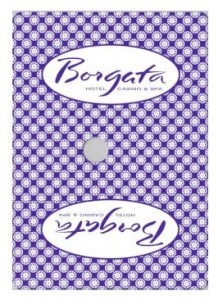Atlantic City’s Borgata Hotel Casino & Spa continues its attempts to pull back $9.6 million from prominent poker pro Phil Ivey in a lawsuit over the “edge sorting” practices employed by Ivey and a playing companion at the casino’s mini-baccarat tables in 2012. In the latest developments, however, it’s Ivey who’s taking the offensive, filing a countersuit against the Borgata for fraud and intentional destruction of evidence.
 Meanwhile, both Ivey and the Borgata seek to shift as much of the blame as possible onto Gemaco, the Kansas-based card manufacturer. In the Borgata’s case, it seems to be an attempt to force Gemaco into an insurance settlement of some form, though as Ivey’s attorney’s latest filing shows, it’s not at all clear that Gemaco has done anything wrong.
Meanwhile, both Ivey and the Borgata seek to shift as much of the blame as possible onto Gemaco, the Kansas-based card manufacturer. In the Borgata’s case, it seems to be an attempt to force Gemaco into an insurance settlement of some form, though as Ivey’s attorney’s latest filing shows, it’s not at all clear that Gemaco has done anything wrong.
Nothing’s going easy in the this heated legal battle, which still appears on track for a jury trial at some point in 2016. And the three-way tug-of-war may turn out to be a story of who’s got the money, meaning the $9.626 million that went into Ivey’s bank account back in 2012. After all, as the saying goes, possession is nine tenths of the law.
A bit of a recap: Following the revelation of a lawsuit by Ivey against London’s Crockfords Casino in 2013, after Crockfords withheld $12 million in winnings, evidence quickly accumulated that Ivey and his playing companion, Cheng Yin Sun, had employed a card-identification tactic known as “edge sorting” in order to shift the game’s odds significantly in Ivey’s favor.
Ivey and Sun later admitted to using the tactic in multiple casinos, including the Borgata. Last year, emboldened by the British case, Borgata parent company Marina District Development Co., LLC sued Ivey, Sun and the maker of the cards in use, Gemaco, attempting a legal clawback of the $9.626 million won by Ivey in four different 2012 mini-baccarat sessions.
It’s true that a British court ruled in favor of Crockfords, refusing to make the casino pay Ivey his winnings. It’s also true, in the US-based Borgata case, that the Borgata already paid Ivey the $9.6 million in question, back when the games were played. Further, despite public assertions by the Borgata’s attorney that Ivey’s alleged cheating was “actionable” under New Jersey law, the Borgata either never took that action in a timely basis (six months) or was turned down in an initial complaint by the New Jersey Division of Gaming Enforcement.
Meanwhile, Gemaco was dragged into the Borgata affair as a co-defendant by the Borgata — as was Sun, Ivey’s sharp-eyed assistant — even though it appears that the cards in question were printed according to the Borgata’s own specifications.
Ivey, too, in his attorney’s latest filing, tries to shift blame onto cardmaker Gemaco. Which just goes to show: When there’s $10 million at stake, the responsibility and “blame” is always someone else’s.
The latest filing from Ivey’s attorney, Louis A. Barbone, is a doozy. It lays bare several of the claims made by the Borgata, which if Barbone’s assertions are true, comes off as a negligent and freerolling casino that discovered too late that its own game specifications weren’t good enough and now wants someone else to pay for that oversight.
In that filing, Ivey’s attorney accuses the Borgata of “fraudulent concealment by way of intentional spoliation of evidence” — the “spoliation” being the fancy legal word for the alleged destruction by the Borgata of the specific cards used in the mini-baccarat games that Ivey played.
It seems logical that if the Borgata wanted to take back $9.6 million from Ivey, and/or prove that the cards used were somehow defective, they’d have kept the actual cards, right? Except Ivey’s attorney alleges that the Borgata failed to do exactly that. Only the cards from one of the four sessions played by Ivey at the Borgata in 2012 — the final one, in October — may still be in existence as possible evidence. The countersuit isn’t clear on that, but states that for sure, the cards from the first three Ivey sessions that summer aren’t available.
 Further, the counterclaim states that the sample card image introduced by the Borgata as part of its suit is just that: a sample, and not from one of the actual decks used in the Ivey sessions, even if it’s the same full-bleed, purple-backed “Gem” style card made by Gemaco, and specifically asked for by Ivey and Sun for its high visibility. (Sample image of such a card at right.)
Further, the counterclaim states that the sample card image introduced by the Borgata as part of its suit is just that: a sample, and not from one of the actual decks used in the Ivey sessions, even if it’s the same full-bleed, purple-backed “Gem” style card made by Gemaco, and specifically asked for by Ivey and Sun for its high visibility. (Sample image of such a card at right.)
According to the countersuit, which also asks that the original claim be dismissed under New Jersey’s “frivolous lawsuit” codes, the Borgata “intentionally destroyed each and every card and deck of cards it produced for play to defendants Ivey and Sun” during the sessions in question.
The counterclaim also asserts that each and every one of those decks were approved for play by both the casino and by New Jersey DGE regulators, and that they had already been found to be within normal print tolerances, per the production contract between Borgata and Gemaco, the cards’ supplier. In other words, the counterclaim essentially states, the Borgata is lying, and the cards weren’t defective at all, just not secure enough to withstand the sort of visual scrutiny employed by Sun, known in casino-security matters as the “Queen of Sorts,” as she assisted Ivey.
Though the counterclaim states that the cards weren’t defective, and thus the supplying of them wasn’t Gemaco’s fault, it’s interesting to note that Gemaco isn’t party to this later counterclaim. There are a couple of reasons why.
First, as I’ve mentioned in other reports, Gemaco is a veteran supplier of cards in the casino and entertainment industry, and the company is likely stepping very carefully in regards to its business reputation, mindful of the potential impact that pushing hard against one of its casino customers might have.
Second, it’s not as if Gemaco and Ivey (and Ivey’s attorney) have reason to be buddy-buddy. It’s Ivey and Sun, after all, who extracted nearly $10 million from the casino industry by exploiting a very minor but still-visible asymmetry in the cards Gemaco produced. The counterclaim also absolves Ivey’s and Sun’s responsibility by stating that it was Gemaco who produced the cards, even if those cards weren’t technically defective.
According to Ivey’s crossclaim, “… defendants [Ivey and Sun] deny any and all liability, obligation or damage to the plaintiff [Borgata], and deny any negligence in any regard to the plaintiff. [T]hey assert that their negligence, if any, was passive and imputed, whereas the negligence of co-defendant Gemaco, Inc. was active and primary.”
Translation: “It’s not our fault if the cards weren’t good enough to withstand the systematic ruse we used.”
No love lost, indeed. Neither Ivey and Sun nor the Borgata want to shoulder the responsibility for the mini-baccarat games running as they did. Ivey and Sun asked for and received an entire series of largely outlandish conditions, the least of which was the use of the bright purple “Gem” cards, even though they were never permitted to touch the cards themselves.
Other agreed-to conditions included a Mandarin-speaking dealer, the willing rotation of “lucky” cards by 180 degrees, the mandatory use of an automatic card shuffler, and more, all spread over four sessions in five months and nearly $10 million in losses, from the Borgata’s viewpoint. How could the Borg not examine the game conditions more closely at the time they occurred?
Further, neither Gemaco nor the Borgata seems to want to admit that the use of a borderless or “full bleed” card design is a huge part of the case as well. Had they used a bordered card, with white around the edges, a scheme such as Ivey’s and Sun’s would have been impossible to pull off. The borderless designs, like the image above, are considered “classier.” Casinos order these full-bleed card designs upon request; they don’t have to be made that way. This writer noticed an image from a Borgata poker event running this week which showed, you guessed it, purple borderless cards.
It’s more than a bit ironic that casinos refuse to reassess their preference for such designs in the face of irrefutable proof that such cards can be manipulated by dedicated schemers. Then again, Crockfords did freeroll the legal system in -their- case against Ivey….
It’s hard to pick a party that’s “right” in this battle, except maybe the cardmaker, Gemaco, who printed cards according to order, made them within tolerances (at least according to the latest Ivey counterclaim), and yet still has to defend itself. Both Ivey and Sun and the Borgata, however, tried to manufacturer an edge over the other. The Borgata’s edge was historical and traditional in the games they offered, and Ivey reversed that, manufacturing his own edge. The Borg has alleged that he broke the law in doing so, but their presumed attempt to get the New Jersey DGE involved went nowhere in a hurry.
Frankly, it’s hard to feel warm and fuzzy about either one of them, the Borgata or Phil Ivey. It’s a zero-sum game all around, and both of them have tried or are trying to angleshoot the other. In the middle of it all sits Gemaco, with no good options.
100% up to $3,000 Bonus
Bovada is our most recommended ONLINE CASINO and POKER ROOM for US players with excellent deposit options. Get your 100% signup bonus today.




Leave a Reply
You must be logged in to post a comment.